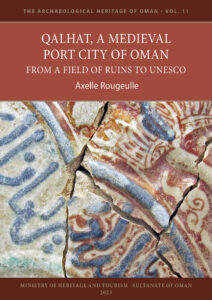Qalhat, a Medieval Port City of Oman From a Field of Ruins to UNESCO
 Although it is one of the main archaeological sites in Oman, the medieval port of Qalhat, near Sur in Ash-Sharqiyah Governorate, has long remained poorly documented. The extensive research initiated in 2008 by the Ministry of Heritage and Tourism (at the time, Heritage and Culture) shed striking light on the history of this famous harbour city, which was the twin capital of the Kingdom of Hormuz from the 13th to the 16th century. Surface surveys and excavations have revealed the plan and chronology of the city and its different districts. Mosques (including the Great Mosque built by Bibi Maryam around 1300) and other religious buildings, fortifications, and water supply systems have been identified and studied. The craft and economic activities of the city and the regional and international commercial links of the port have been reconstructed, as well as the daily life of its inhabitants, revealing the wealth and cosmopolitan character of this ancient Omani metropolis. All these results highlighted the Outstanding Universal Value of the site and eventually led to the inscription of Qalhat on the UNESCO World Heritage List in 2018.
Although it is one of the main archaeological sites in Oman, the medieval port of Qalhat, near Sur in Ash-Sharqiyah Governorate, has long remained poorly documented. The extensive research initiated in 2008 by the Ministry of Heritage and Tourism (at the time, Heritage and Culture) shed striking light on the history of this famous harbour city, which was the twin capital of the Kingdom of Hormuz from the 13th to the 16th century. Surface surveys and excavations have revealed the plan and chronology of the city and its different districts. Mosques (including the Great Mosque built by Bibi Maryam around 1300) and other religious buildings, fortifications, and water supply systems have been identified and studied. The craft and economic activities of the city and the regional and international commercial links of the port have been reconstructed, as well as the daily life of its inhabitants, revealing the wealth and cosmopolitan character of this ancient Omani metropolis. All these results highlighted the Outstanding Universal Value of the site and eventually led to the inscription of Qalhat on the UNESCO World Heritage List in 2018.
Contents
Introduction
- History of research at Qalhat
- Qalhat, rise and fall of an Omani port city, from the pre-Hormuzi to the Portuguese period
- Urban planning of the town in the 14th-15th centuries
- Qalhat, a heavily fortified city
- Getting water in Qalhat, the water supply system of the town
- The Great Mosque of Bibi Maryam
- The Bibi Maryam mausoleum and other religious structures
- Official and public buildings
- Domestic life in Qalhat: The twin houses with Vladimir Dabrowski, Anaïs Marrast, Hervé Monchot and Hélène Renel
- Economy and trade with Thomas Creissen, Fabien Lesguer and Hélène Renel
- Qalhat, a World Heritage site with Alessandra Peruzzetto
Bibliography
Index




